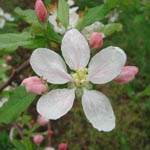Research Areas
Tree architecture
 The basis of apple production is all about spurs producing apple fruit. The trick for growers is to arrange spurs on branches and trees so that each acre has the right number and arrangement of high quality spurs bearing high quality fruit. This is what we mean by “tree architecture”. Pruning is an annual practice performed by growers to optimize the arrangement of branches and spurs for productivity, fruit quality and ease of orchard operations.
The basis of apple production is all about spurs producing apple fruit. The trick for growers is to arrange spurs on branches and trees so that each acre has the right number and arrangement of high quality spurs bearing high quality fruit. This is what we mean by “tree architecture”. Pruning is an annual practice performed by growers to optimize the arrangement of branches and spurs for productivity, fruit quality and ease of orchard operations.
We are taking a number of approaches to further study tree architecture:
- Tree canopy reconstruction using LIDAR and Kinnect sensors (in collaboration with Dr Avinash Kak, Purdue Dept Electrical and Computer Engineering). This work is the necessary first step to automate pruning.
- Use canopy reconstructions to develop a tree growth model , (with Dr Bedrich Benes, Purdue Dept. of Computer Graphics). The model, called IMapple (interactively Modeled Apple), has potential applications in predicting pruning responses, and education.
Hirst is project director of a USDA-SCRI funded project ($6.0 m) that seeks to integrate knowledge of tree architecture and machine vision to enable robotic pruning of apple and grape canopies. Hirst has previously published extensively in the area of apple tree architecture. This project, involves engineers, horticulturists, rural sociologists and an economist from academic institutions and a commercial partner. At the end of the 4 year project, we aim to make available a commercial prototype of a fully automated pruner for grapevines. In addition, we will develop algorithms and engineering solutions to enable an apple robotic pruner to be developed. Learn more about pruning automation at www.pruningautomation.com
Fruit Development
Flowering
 Fruit development starts around July with vegetative buds transitioning to floral buds that later produce the following year’s crop. A more detailed understanding of the flowering process is
Fruit development starts around July with vegetative buds transitioning to floral buds that later produce the following year’s crop. A more detailed understanding of the flowering process is
necessary to underpin the development of control strategies by farmers. Our research has shown that considerable variation exists in the timing, duration, and ultimate degree of flower differentiation in a range of genotypes. Many key management practices are predicated on the time and control of flower initiation, and this research has the potential to allow a greater
level of precision in these practices. Such refinement could result in higher, more consistent cropping, increased fruit size, and higher fruit value. Our work on Honeycrisp has shown that overall tree crop load is important in regulating flowering only when fruit are thinned to single fruit per spur. Spurs with two fruit are unlikely to produce flowers for the following year, regardless of overall tree crop load.
Pollination
 Apples require cross pollination but not all sources are equally effective. Our work has shown that two species of crab apple, Ralph Shay and Malus floribunda, are ineffective pollinizers of Honeycrisp apple. Approximately 3-4 days are required for pollen tubes to reach the ovary, but some genotypes seem to grow faster then others.
Apples require cross pollination but not all sources are equally effective. Our work has shown that two species of crab apple, Ralph Shay and Malus floribunda, are ineffective pollinizers of Honeycrisp apple. Approximately 3-4 days are required for pollen tubes to reach the ovary, but some genotypes seem to grow faster then others.
Fruit Growth

Apple Cross Section
We are taking innovative approaches to studying fruit size and fruit development in apples. Our program is the only program in the world using unique Gala apple mutants to study fruit size. Using these mutants, we have identified the process of endoreduplication in apple for the first time (J. Exp. Bot 2010). We have cloned 4 cell-cycle genes in apple, and 2 of these appear to play a role in regulating fruit size. Work currently underway is examining genome-wide expression of genes during early fruit development in Gala mutations using next generation sequencing. Alignment of transcriptomes with the published apple genome is currently being performed for RNA-Seq analysis to study differential gene expression. We are also studying apple fruit growth in terms of cell division and cell enlargement. Many factors affect fruit size and it appears some increase cell production and some lead to greater cell enlargement. In other words, different methods of improving fruit size act in different ways, with implications for fruit quality and post harvest performance.
Rootstock Evaluation
Rootstocks form the basis for modern orchard systems . However not all rootstocks are suitable for indiana growers. As a founding member of the NC-140 regional rootstock project, Purdue continues to be involved in this award-winning research program.